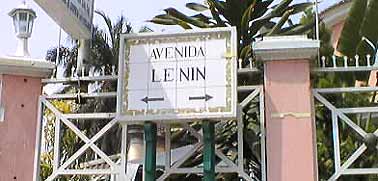Trickle-down economics Angola-style, petro-diamond
capitalism, an oil boom in a land of flickering
electricity, and an encounter with a child
"Não há agua hoje." Dona
Josinha tells me what I learned standing undressed in the shower
moments
ago, attempting to make the most of a trickle. There is no
water today.
When the lights go out, you hope the generator
kicks in, but there
are
always
candles. When the water goes out, you first look to your reserves – ours
is a 24-gallon garbage can in the kitchen – but when
that is exhausted, a trip to the water vendors will be necessary.
A majority of the poor in Angola rely on the water vendors
to meet their daily needs. The costs are exorbitant. A recent
Christian Aid report described the plight of a family who spent
$2.75 out of their daily income of $3.50 on water. The
water isn't exactly spring water either – it often carries
disease.
| |

The door to the "entrepisos" level |
I carefully navigate the slick steps down to the ground floor.
The boys living "entrepisos" (literally: between
floors) in the small space below our floor are hauling dripping
plastic bags filled with water to the apartments above for
spare change. On the street, women are ferrying heavy jerry
cans of water on their heads. Some women collect water for
their families by placing buckets under the eaves of the well-to-do's
apartment buildings to catch the condensation dripping from
the air conditioning units. This is the way trickle-down economics
works around here.
The walk to the Angolan Research Institute (A-IP, which will
serve as the home base for my research) is probably about a
mile.
It is 8 a.m. and the sun is mild, but
the heat
mixed with the dust and exhaust
from
the endless stream of SUVs, trucks and cars is almost suffocating.
There are few streetlights and fewer that are obeyed. Crossing
the street can be a life-threatening ordeal, especially with
four lanes of traffic. At the Kinaxixi (pronounced "Kee-nah-sheesh")
roundabout, I turn down Avenida Lenin. Despite the transition "from
Afro-Stalinism to Petro-Diamond Capitalism" (as the keen
author Tony Hodges describes it), many of Luanda's street
names bear witness to its Marxist-Leninist past.
The walk along
Lenin is pleasantly shaded. The brightly painted colonial-style
cement homes with their plantation shutters range from well
kept to dilapidated – one has a rooster poking about
on the front porch. When the Portuguese left in 1975, some
sabotaged their homes and cars before escaping the country.
The remnants of this destruction remained frozen in time, compounded
by 27 years of further deterioration over the war period. But
with peace, construction is on the rise, especially with the
aid of foreign business investments.
However, the streets of Luanda tell the story of both rich
and poor. The gleaming towers along the waterfront and BMW
SUVs contrast with the cardboard and sheet metal shelters.
Street vendors sell fish, donuts, fruits, clothing, shoes,
combs – whatever they can. A young man in a faded blue
shirt shows me his wares: a scooter and a bathroom scale. Not
far from here in the high-rises of the "baixa" zone,
multi-million dollar contracts for oil exploration are signed.
And still, with nearly one million barrels of oil produced
per day, the electricity flickers off, leaving most Angolans
in the dark.
After a day at A-IP, I emerge from the office to a molten
sunset. Taking the long way home, I wander through the small
streets
lit with smoldering fires. Turning up my street and just past
the petrol station I see a barefoot child picking through a
heap of trash. A mangy dog noses through the opposite end of
the heap, its battered tail between its legs. As I step toward
the child, headlights blind me. Backpedaling, nearly into a
pool of stagnant liquid (I won't pretend it's water),
I look up. The child is gone.
— Kristin

